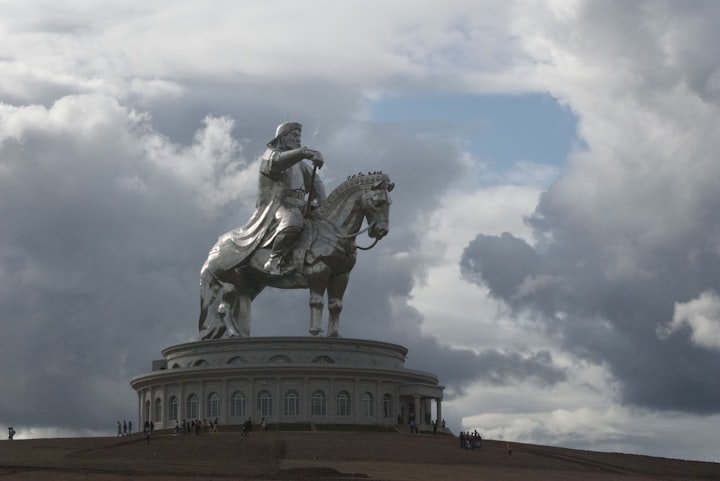
You do not rise to the level of your goals. You fall to the level of your systems. - JAMES CLEAR
From an early age, Genghis Khan (1162-1227) became well-versed in the incessant warfare that plagued the Mongol Steppe for previous centuries.
Even his birth was marked by the chaos of constant raids and violence from neighbouring tribes. His mother, Hoelun, was kidnapped by the Khiyad clan shortly after her first wedding and remarried to Khiyad chief, Yesugei. Soon after, Hoelun gave birth to Temujin (later known as Genghis Khan).
Nine years later, Yesugei died from an apparent poisoning and the Khiyad clan abandoned Hoelun and the children in favor of a rival chieftain. Hoelun taught the children to live off the land and operate as a tight-knit group. But they were left to fend for themselves, living on the run as a poor family.
The family faced a constant threat of conquering, looting, and enslaving that dictated life between neighbouring tribes. This was the reality of Temujin’s childhood. He was shaped by the rugged terrain and harsh life of the steppe.
At fifteen, Temujin was captured and enslaved by the Tayichiud, a clan of Mongol elites who considered themselves the high-born lineage. Temujin was given as a prisoner to the servant families who provided him small comforts – water, food, sleep, care – outside of the watchful eye of the Tayichiud.
During an attempted escape, Temujin hid in the tall grass on the edge of a nearby river only to be discovered by the father of one of the servant families. Instead of sounding the alarm, the old man helped conceal Temujin. He removed Temujin’s constraints and hid him in a pile of wool in his family’s home until there was a better opportunity to escape. This would have a lasting impact on Temujin, as a family without direct kinship to him risked their lives for his without hesitation.
After his escape, Temujin made his way back to the woman he was promised to marry, Borte of the Khongirad clan. His father had arranged the marriage close to a decade earlier to unite the two families. For their first year, Temujin and Borte sought to live a quiet life in an isolated region near the Kherlen River.
But early one morning, an enemy raiding party caught the family off guard. During the chaos of the attack, Borte was captured and Temujin barely escaped with his life to the mountains in the north. He now faced a pivotal decision – accept the constant turmoil which defined life on the steppe or set out to rescue Borte and change things once and for all.
If there’s one thing Temujin’s brutal upbringing taught him, it was an instinct for survival and self-preservation. But up until this point, he survived on tactics and quick-witted reactions in the heat of the moment. If he chose to rescue Borte and alter life on the steppe, this would require strategy, calculated action, and a deep understanding of the interconnected whole.
Ultimately, Temujin chose the latter. After Borte’s capture, he realized that stability would be impossible under the status quo and he entered into the arena of war.
It wouldn’t be long before he rescued Borte. But this was the turning point when he set out to eliminate the dysfunction that riddled the steppe, including a strict caste structure based on birthright, replacing it with one based on individual merit and loyalty.
As he moved forward, crushing rivals, Genghis Khan demonstrated a remarkable ability to step back and consider the larger forces at play. While other tribal leaders continued to focus on the minute details immediately in front of them – the latest spat, the next raid, a short-sighted plot for revenge – he saw beyond this.
He encouraged petty rifts and outdated traditions to fall by the wayside so he could focus on the bigger picture – delivering stability to the Mongol Steppe, searching for philosophical lessons in other religions, discovering technical innovation in other cultures.
But as the Mongol Empire expanded outward, there was too much new information for him to sort through on his own. Instead of allowing himself to become a prisoner of his own ignorance, he established a diverse council of intelligent advisors and generals whom he trusted implicitly to help conduct the affairs of the empire. His focus was on getting the conditions right, not wasting energy on insignificant details.
To eliminate animosity and build camaraderie within his army, Genghis Khan organized warriors across tribes and kin into units of ten to fight and live together. These self-sufficient units also lived off the land and traveled without a supply chain. This allowed them to move faster than any army in history – conquering more lands in twenty-five years than the Romans had in four hundred years.
In terms of the social fabric, all conquered people (with the exception of aristocrats) were taken into his tribe as equal members in good standing. This helped break the caste system of old and establish a new allegiance. He also introduced laws that prevented the enslavement of any Mongol, declared all children legitimate, forbade the selling of women into marriage, and decreed total religious freedom.
Though he practised Tengrism, an animistic religion, he saw a moral and philosophical value in all religions. He brought in missionaries who were Buddhist, Muslim, Christian, and Taoist. He cared less about what religion his subjects practised, as long as they observed the fundamental laws of the land.
With this approach, Genghis Khan was able to rise above petty conflict, embrace cultural differences, and build systems for larger victories. As a result, he inspired a deep loyalty in his people and was the first leader to unite the Mongol Steppe.
What does this story from the life of Genghis Khan teach us?
As Genghis Khan demonstrated so well, a systems mentality is about getting above the trenches so you can see the terrain. It’s the ability to understand the interconnected whole – the structures, patterns, and cycles – instead of being blinded by a single event or moment in time.
With this mindset, you can focus on a few things that have the largest impact and ignore the inconsequential drama that most people succumb to on a daily basis.
Genghis Khan wasn’t sitting around obsessed with gossip, retaliation, or clinging to traditions that no longer made sense. He let these go so he could focus on something bigger – introducing a new way of life in the Mongol Steppe. He empowered his advisors and generals to do their jobs, leading operations and tactics. This freed him to look further ahead and fine-tune his strategic approach – from the structure of his military to the declaration of religious freedom – helping to bridge existing rifts.
Success doesn’t come from being better at preventing things from falling through the cracks. It comes from knowing what to let fall through.
This frees you to focus your limited time and energy on what matters most. By assigning things their proper value, you’re able to preserve a deep sense of calmness and rationality in the face of uncertainty.
You can identify those who have failed to build a systems mentality by how overwhelmed they get by minutiae – especially when the stakes are at their highest. They become fixated on insignificant things, gripping for control in their foolish quest for perfection. They’re unable to let the little things go.
A systems mentality starts with pausing to consider the broader context before taking action. If you pair this with ruthless prioritization and the Pareto Principle – focusing on the twenty per cent that generates eighty per cent of the results – you build the mindfulness to pull yourself out of the trenches, assess the forces at play and determine what warrants your attention.






Comments
There are no comments for this story
Be the first to respond and start the conversation.